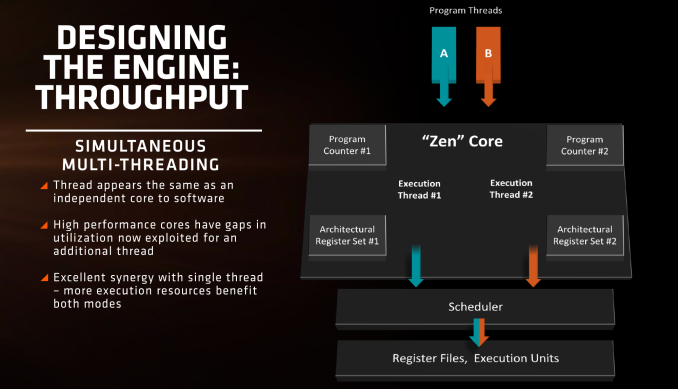AMD Zen Microarchitecture: Dual Schedulers, Micro-Op Cache and Memory Hierarchy Revealed
by Ian Cutress on August 18, 2016 9:00 AM ESTSimultaneous Multi-Threading
On Zen, each core will be able to support two threads in what is called ‘simulatenous multi-threading’. Intel has supported their version of SMT for a number of years, and other CPU manufacturers like IBM support up to 8 threads per core on their POWER8 platform designs. Building a core to be able to use multiple threads can be tough, as it requires a lot of resources to make sure that the threads do not block each other by consuming all the cache and buffers in play. But AMD will equip Zen with SMT which means we will see 8C/16T parts hitting the market.
Unlike Bulldozer, where having a shared FP unit between two threads was an issue for floating point performance, Zen’s design is more akin to Intel’s in that each thread will appear as an independent core and there is not that resource limitation that BD had. With sufficient resources, SMT will allow the core instructions per clock to improve, however it will be interesting to see what workloads will benefit and which ones will not.
Timeframe and Availability
At the presentation, it was given that Zen will be available in volume in 2017. As the AM4 platform will share a socket with Bristol Ridge, users are likely to see Bristol Ridge systems from AMD’s main OEM partners, like Dell and others, enter the market before separate Zen CPUs will hit the market for DIY builders. It’s a matter of principle that almost no consumer focused semiconductor company releases a product for the sale season, and Q1 features such events as CES, which gives a pretty clear indication of when we can expect to get our hands on one.
It’s worth noting that AMD said that as we get closer to launch, further details will come as well as deeper information about the design. It was also mentioned that the marketing strategy is also currently being determined, such that Zen may not actually be the retail product name for the line of processors (we already have Summit Ridge as the platform codename, but that could change for retail as well).
Wrap Up
AMD has gone much further into their core design than I expected this week. When we were told we had a briefing, and there were 200-odd press and analysts in the room, I was expecting to hear some high level puff about the brand and a reiteration of their commitment to the high end. To actually get some slides detailing parts of the microarchitecture, even at a basic cache level, was quite surprising and it somewhat means that AMD might have stolen the show with the news this week.
We’ve got another couple of pieces detailing some of the AMD internal/live benchmark numbers during the presentation, as well as the dual socket server platform, the 32-core Naples server CPU, and what we saw at the event in terms of motherboard design.











216 Comments
View All Comments
Jleppard - Thursday, August 18, 2016 - link
I like AMD and a fan. The agreement with Intel products Intel regardless if the allow someone else that would buy AMD from keeping X64 available to Intelfoobaz - Thursday, August 18, 2016 - link
Wouldn't the patents from their prior dispute be expired by now? That was a long time ago.Gigaplex - Thursday, August 18, 2016 - link
Some of them may have expired, but there are newer ones that haven't.wiak - Thursday, August 18, 2016 - link
AMD created AMD64 in 2000 and then released it in Athlon 64/Opteron then intel copied and called it EMT64 then everyone started calling it x86-64there is alot of references to amd64 in windows and ubuntu (amd64 isos etc)
https://en.wikipedia.org/wiki/X86-64#History
owan - Thursday, August 18, 2016 - link
Again, not a copy. They licensed it and branded it as their own thing.StormyParis - Thursday, August 18, 2016 - link
a legal copy is still a copy ?ianmills - Thursday, August 18, 2016 - link
Intel licensed the technology so they could copy it. I'm not sure what distinction you are tying to make :PMaybe you are trying to say Intel didn't steal the technology?
sorten - Thursday, August 18, 2016 - link
I think the point was in response to the OP, who was suggesting that AMD only ever copies Intel. The example of AMD64 is one where AMD was the innovator, though that's ancient history now.joex4444 - Thursday, August 18, 2016 - link
Nobody's disputing that AMD invented it. But what do you want Intel to do? Create their own and then all software companies have to support 32-bit, AMD64, and Intel64?Ej24 - Thursday, August 18, 2016 - link
Intel was close to releasing their own and gave up on consumer Intel64 when AMD beat them to market. Though I believe Intel still implemented it in some form in their Itanium brand?